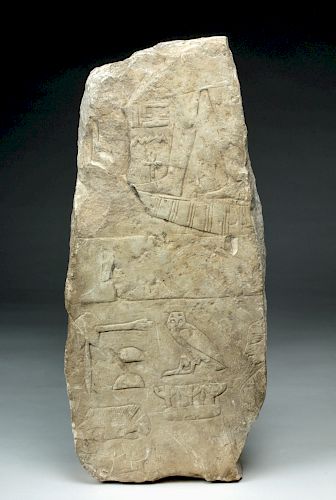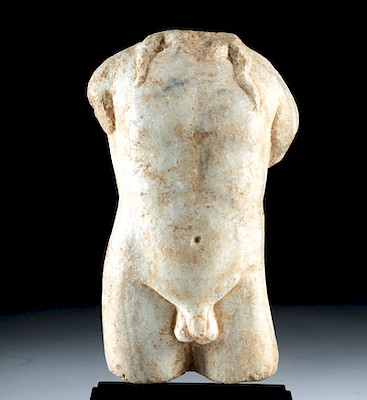Egyptian Limestone Panel w/ Ripple of Water Hieroglyph
Lot 11
About Seller
Artemis Fine Arts
686 S Taylor Ave, Ste 106
Louisville, CO 80027
United States
Selling antiquities, ancient and ethnographic art online since 1993, Artemis Gallery specializes in Classical Antiquities (Egyptian, Greek, Roman, Near Eastern), Asian, Pre-Columbian, African / Tribal / Oceanographic art. Our extensive inventory includes pottery, stone, metal, wood, glass and textil...Read more
Estimate:
$9,000 - $12,000
Absentee vs Live bid
Two ways to bid:
- Leave a max absentee bid and the platform will bid on your behalf up to your maximum bid during the live auction.
- Bid live during the auction and your bids will be submitted real-time to the auctioneer.
Bid Increments
| Price | Bid Increment |
|---|---|
| $0 | $25 |
| $300 | $50 |
| $1,000 | $100 |
| $2,000 | $250 |
| $5,000 | $500 |
| $10,000 | $1,000 |
| $20,000 | $2,500 |
| $50,000 | $5,000 |
| $100,000 | $10,000 |
| $200,000 | $20,000 |
About Auction
By Artemis Fine Arts
Dec 5, 2018
Set Reminder
2018-12-05 10:00:00
2018-12-05 10:00:00
America/New_York
Bidsquare
Bidsquare : DAY 1 | Classical Antiquities & Asian Art
https://www.bidsquare.com/auctions/artemis-gallery/day-1-classical-antiquities-asian-art-3698
Day 1 of an important 2-day auction featuring ancient and ethnographic art from around the world. Egyptian, Greek, Roman, Viking, Near Eastern plus Asian Art from China, Japan, Thailand, Vietnam, Burma, India, more. Artemis Fine Arts info@artemisfinearts.com
Day 1 of an important 2-day auction featuring ancient and ethnographic art from around the world. Egyptian, Greek, Roman, Viking, Near Eastern plus Asian Art from China, Japan, Thailand, Vietnam, Burma, India, more. Artemis Fine Arts info@artemisfinearts.com
- Lot Description
Ancient Egypt, New Kingdom / Third Intermediate Period, ca. 1550 to 712 BCE. A fragment of a carved limestone panel depicting a series of hieroglyphs on its lower half and the lower part of a standing anthropomorphic figure on its upper half. The lower body includes a small ankh, symbol of life, by its striding front foot. The zigzagging Ripple of Water hieroglyph is carved by the knee and some other, fragmentary symbols, probably other hieroglyphs, are carved above it. The figure stands on a vertically incised, curved boat - part of the fishing scene on the journey to Sht-Htp. The hieroglyphs are much more complete, with the owl (G17), tilapia (K1), part of a different kind of fish (probably K3), two buns (X1), and a building component, probably a variant of O43. This is a caption that translates as "shooting fish in the marsh". A human face is seen to the right of the fragment, lost behind the eye. Size: 2.05" L x 7.95" W x 17.4" H (5.2 cm x 20.2 cm x 44.2 cm)
The carved (rather than simply painted) and brightly colorful nature of this relief indicates that it was from a prestigious location - most likely a major temple, but also possibly a high ranking official's tomb or even a palace. Images like this one were part of larger stories, usually a journey through the afterlife or meeting deities in the afterlife, that were designed to help people understand religious concepts and, if found in a tomb, to introduce the dead to their new world. Hieroglyphic inscriptions offered prayers and advice for the dead.
Provenance: private St. Louis, Missouri, USA collection; ex Atlanta, Georgia, USA collection, acquired before 1990
All items legal to buy/sell under U.S. Statute covering cultural patrimony Code 2600, CHAPTER 14, and are guaranteed to be as described or your money back.
A Certificate of Authenticity will accompany all winning bids.
We ship worldwide and handle all shipping in-house for your convenience.
#128939Piece is a fragment, with rough edges. Much of the panel face is clear, aside from loss at the top left (facing) as shown. Surface scratching commensurate with age and handling, but it does not obscure the remaining artwork.Condition
- Shipping Info
-
All shipping is handled in-house for your convenience. Your invoice from Artemis Gallery will include shipping calculation instructions. If in doubt, please inquire BEFORE bidding for estimated shipping costs for individual items.
-
- Buyer's Premium



 EUR
EUR CAD
CAD AUD
AUD GBP
GBP MXN
MXN HKD
HKD CNY
CNY MYR
MYR SEK
SEK SGD
SGD CHF
CHF THB
THB














